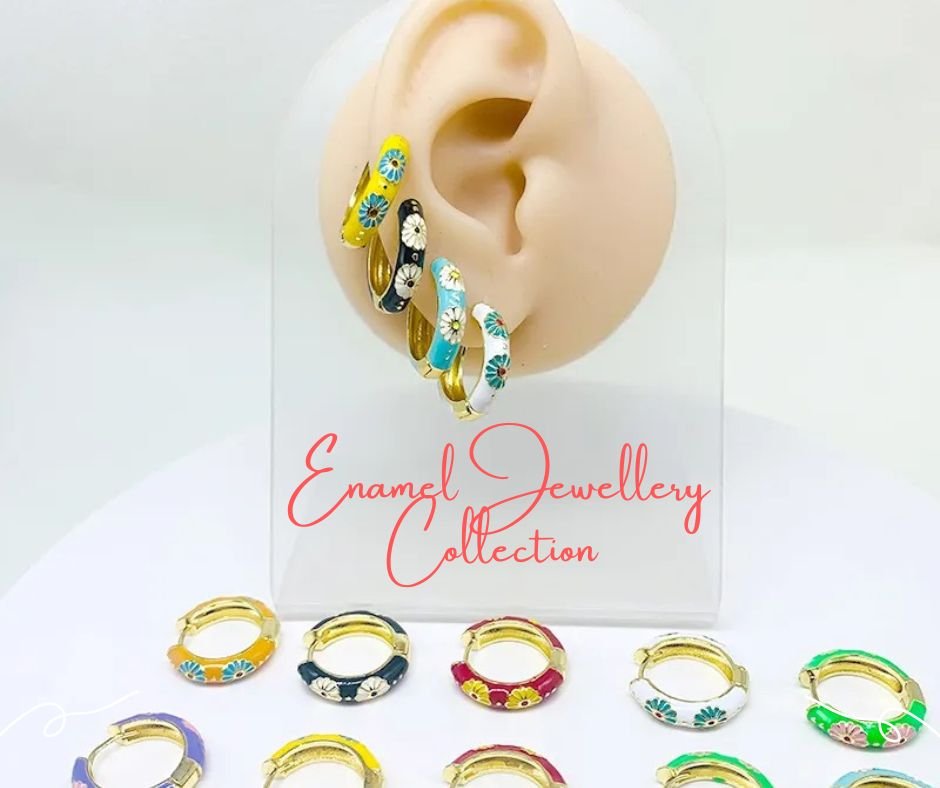In jewellery, enamel refers to a decorative technique that involves fusing powdered glass to a metal surface, typically gold, silver, or copper, through a high-temperature firing process. The result is a smooth, colourful, and durable coating that enhances the beauty and intricacy of the jewellery piece.
Enamelling has been used in jewellery-making for centuries and is valued for its vibrant and long-lasting colours. The process involves several steps:
- Preparation: The metal surface, usually a gold or silver base, is cleaned thoroughly to remove any oils, dirt, or impurities that might interfere with the adhesion of the enamel.
- Application: Fine glass powder, available in various colours, is carefully applied to the metal surface. Jewellers use various techniques like cloisonné (using metal wires to create compartments for the enamel) or champlevé (carving out areas in the metal to hold the enamel).
- Firing: The jewellery piece is then fired in a kiln at high temperatures, typically between 750 to 850 degrees Celsius (1380 to 1560 degrees Fahrenheit). During firing, the glass powder melts and fuses with the metal, forming a smooth and colourful layer.
- Cooling and Polishing: After firing, the piece is allowed to cool, and then it may be polished to achieve a glossy and lustrous finish.
Enamel can be translucent or opaque, and artists can create intricate designs and patterns using this technique. It allows for a wide range of colours and shades, adding a vibrant and artistic element to the jewellery. Enamel work can be found in various styles, including ancient techniques like Byzantine or Cloisonné enamel, as well as more modern or contemporary approaches. It remains a popular and cherished form of artistic expression in the world of jewellery-making.
Is enamel good for jewellery?
Yes, enamel is an excellent material for jewellery. It provides a wide range of colours and finishes, allowing for unique and artistic designs. Enamel is durable and can withstand everyday wear, making it suitable for various types of jewellery. Its smooth and glossy surface adds elegance and sophistication to jewellery pieces, complementing different metal types. However, enamel jewellery requires proper care to maintain its beauty over time, avoiding exposure to harsh chemicals, extreme temperatures, or hard impacts. Despite this, enamel remains a popular and captivating choice for creating exquisite and vibrant jewellery pieces.
How is enamel applied to jewellery?
Enamel is applied to jewellery through a process called enamelling. There are several techniques, but the two main methods are cloisonné and champlevé.
In cloisonné, thin metal wires are bent and affixed to the metal surface to create small cells or compartments. These cells are then filled with different coloured enamels. The piece is then fired at high temperatures to melt and fuse the enamel, creating a smooth surface.
In champlevé, recesses are carved into the metal surface, and enamel is applied to these areas. The excess enamel is scraped off, leaving the enamel only in the carved recesses. The piece is fired to achieve the final enamel coating.
When was enamel jewellery popular?
Enamel jewellery has a long and storied history that dates back to ancient times. It was particularly popular during the Byzantine Empire (4th to 15th centuries), where intricate cloisonné enamel work adorned religious artefacts and imperial regalia. Enamel jewellery also flourished during the Renaissance era (14th to 17th centuries) in Europe, where skilled artisans created elaborate and colourful enamel pieces for royalty and the wealthy elite. The Art Nouveau period (late 19th to early 20th century) saw a resurgence of enamel jewellery, with its organic and flowing designs capturing the spirit of the time. Enamel jewellery continues to be appreciated and crafted today.
Is enamel expensive in jewellery?
The cost of enamel in jewellery can vary depending on several factors. High-quality enamel jewellery that is handcrafted with intricate designs and vibrant colours can be quite expensive due to the skilled craftsmanship involved. Additionally, the type of enamel used, such as cloisonné or champlevé, can also influence the price. Enamel jewellery made with precious metals like gold or platinum will generally be more costly than pieces with base metals. However, there are also more affordable options available, such as mass-produced enamel pieces or those with simpler designs. Overall, enamel jewellery can range from moderately priced to high-end and luxurious, catering to different budgets and tastes.
Top enamel manufacturers in India?
There were several renowned enamel manufacturers in India known for their high-quality enamel products. Please note that the landscape of manufacturers may have changed since then, and it’s always a good idea to verify the current information. Monica Silver Jewellery is a well-known enamel jewellery manufacturer, offering a variety of wholesale enamel jewellery pieces. A wide collection of enamel jewelry and monica silver is offered and made at wholesale prices.

